Mizuho Six
The Mizuho Six (ミヅホシックス) are 6×6 folders, made between 1951 and 1955 by a Japanese company that was Mizuho at the start and Neoca by the end.
Contents
General description
All the models of Mizuho Six have diecast bodies, and two red windows for film advance, allowing use of the 4.5×6 as well as 6×6 format. These red windows are protected by a cover sliding under a metal plate, marked 16 EX and 12 EX. There are two hinged flaps inside the exposure chamber, providing a mask for 4.5×6cm exposures, a system which is much more convenient than an easily lost insert.

|
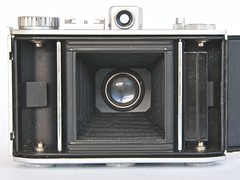
|
| Hinged ('barn-door style') exposure mask on a Mizuho Six. Left closed for 6x6.5, right open for 6x6. Pictures by Dirk HR Spennemann. (Image rights) | |
The model name is engraved on the top plate. The back leather is also embossed Mizuho-Six. There is an MKS logo engraved on the folding struts, at least until the Mizuho Six V. This logo is also present in the folding bed's leather, and on the top plate of the Mizuho Six V. It has also been observed on an original box, and it probably stands for Mizuho Kōki Seisakusho.
All the models but one (the Super T) have an 80mm f/3.5 lens.
Viewfinder models
The original Mizuho Six (subsequently renamed the Mizuho Six I) was released by Mizuho Kōki Seisakusho in 1951. It has a flat top plate with a tubular optical finder protruding from its centre. The folding struts are made of three parts, patterned after those of the Ikonta. The lens is a Miltar Special, marked Mizuho Kōki and Miltar Special © (the latter part was sometimes in uppercase). The shutter is either an MKS with speeds of B, 15–150 or an NKS with speeds B, 1-200.
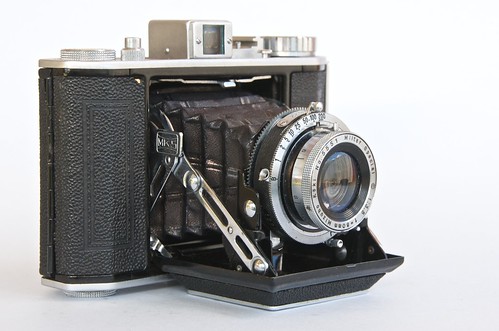
|
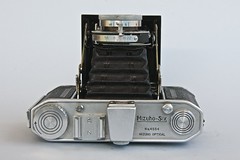
|

|
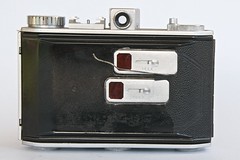
| ||
| Mizuho Six (sn 4554), with Miltar Special © f/3.5 80mm (lens no.5551) in NKS shutter. Pictures by Dirk HR Spennemann. (Image rights) | ||
The Mizuho Six II and III were released in late 1951 or early 1952 and offered jointly with the model I. They only differ in their shutters: the II has an NKS (B, 1–200), the III a Mizuho Synchro IIIM (B, 1–300).
The Mizuho Six IIB and IIIB were released by Mizuho Camera Kōgyō in summer 1952. The IIB has simpler two-part folding struts, a film reminder inside the advance knob and a different accessory shoe. It was advertised in Asahi Camera July 1952 with a three-leaf MKS IIM shutter (B, 1–200) and a Miltar lens.[1] However at least one example, pictured below, is known with a Rubinon Anastigmat lens and an MKS shutter to 1/300, marked MIZUHO–SYNCHRONISED at the bottom, with a self-timer and an ASA synch post.[2]
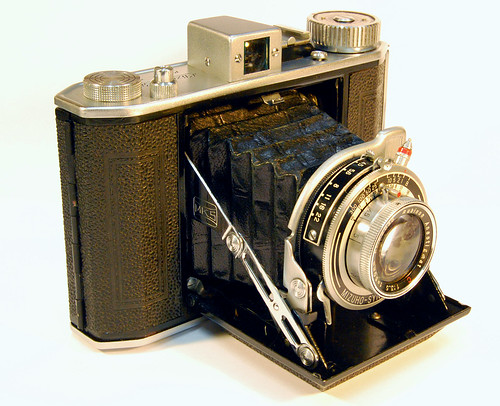
|
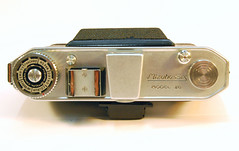
|
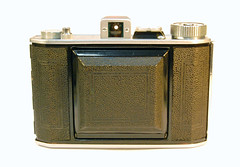
|
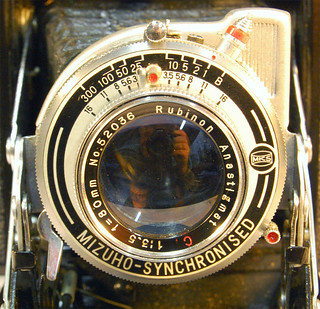
|
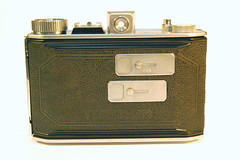
|

| ||
| Mizuho Six IIB, MKS shutter (B, 1–300), Rubinon Anastigmat C. 80mm f/3.5 no.52036. Pictures by Hans Kerensky. (Image rights) | |||
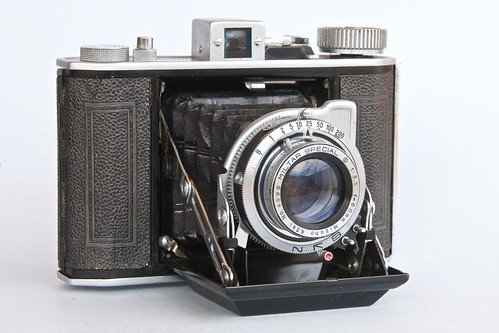
|
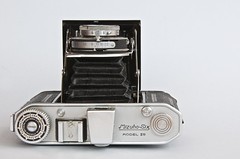
|
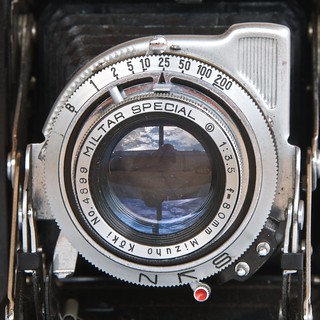
|

| ||
| Mizuho Six IIB, with Miltar Special © f/3.5 80mm (lens no.4889) in NKS shutter. Pictures by Dirk HR Spennemann. (Image rights) | ||
The IIIB has a more elegant top design, with the viewfinder integrated in a top housing, and has the original three-part struts. In the same July 1952 advertisement, it is listed with a five-leaf MKS IIIM shutter (B, 1–300) and a Miltar lens.[1] However it as been observed with a Rubinon Anastigmat lens.[3] The shutter rim is marked MKS-SYNCHRONISED-M-III and there is a self-timer and an ASA bayonet synchro connector.
Rangefinder models

|
| Mizuho Six Model V, Rubinon Anastigmat C lens, Mizuho Synchronized shutter image by eBayer blacks2 (Image rights) |
The Mizuho Six V, released in 1952, had a non-coupled rangefinder. It came with either a Miltar Special or a Rubinon Anastigmat C lens, and any of four shutters: MKS (top speed 200), Nissei-Rapid (500), MKS-MIII (300) and Mizuho MKS (200). The lenses were offered as alternatives without any particular explanation; some advertisements similarly mentioned shutters as alternatives at the same price, others offered a choice of shutters at different prices. It has been observed with an NKS B, 1–200 synchronized shutter and with another shutter with 200–1, B speeds, marked MIZUHO-SYNCHRONIZED with the MKS logo.
Some advertisements for the Mizuho Six V mentioned the Mizuho Six VI as soon to be available. It is described as having a coupled rangefinder and as unit-focussing (the entire lens assembly, and not merely the front element, moves for focussing). It is not clear that the VI was ever released.
In 1954, the Mizuho Six Super was released by the freshly renamed Neoca, delivering on the promises for the VI. (Perhaps the VI was simply renamed.) It had a Rectus shutter (B, 1–200).
In 1955 the Mizuho Six Super N and Super T were released. The Super N was less expensive, with a Neokor lens (described as of Triotar design). The Super T had either a Copal or a New Rectus (新レクタス) shutter (each B, 1–300), and a Tōkyō Kōgaku Toko 75mm f/3.5 lens.
Notes
- ↑ 1.0 1.1 Advertisement reproduced in Kokusan kamera no rekishi, p.191.
- ↑ Example pictured in this page and in this Flickr album by Hans Kerensky.
- ↑ Example pictured here at Japan Family Camera (archived).
Source / further reading
- Asahi Camera (アサヒカメラ) editorial staff. Shōwa 10–40nen kōkoku ni miru kokusan kamera no rekishi (昭和10–40年広告にみる国産カメラの歴史, Japanese camera history as seen in advertisements, 1935–1965). Tokyo: Asahi Shinbunsha, 1994. ISBN 4-02-330312-7. Items 893–9.
- Hagiya Takeshi (萩谷剛). "Hito wo meguru: Mizuho Shikkusu Neoka 35 kara Minokkusu saizu ichigan-refu made Sugaya Sadauji" (人を巡る:ミズホシックス・ネオカ35からミノックスサイズ一眼レフまで菅谷貞氏, Following a man: Sugaya Sadauji, from the Mizuho Six and Neoca 35 to a Minox-size SLR). Shashin Kōgyō July 2002.
Links
In English:
In Japanese:
- Mizuho Six V at Minorhouse
- Mizuho Six V at a page of the AJCC
- Mizuho Six V at doraDD's clacamera blog
- Advertisement for the Mizuho Six published in 1954, reproduced in a page of Japanese postwar advertisements at the Shashin-Bako website
